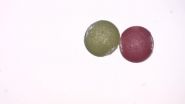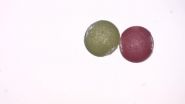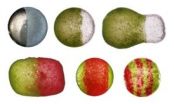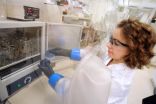(Press-News.org) VIDEO:
Two oil drops, covered with particles of different properties, coalesce due to the action of an alternating electric field, forming a Janus capsule.
Click here for more information.
Everything depends on how you look at them. Looking from one side you will see one face; and when looking from the opposite side – you will see a different one. So appear Janus capsules, miniature, hollow structures, in different fragments composed of different micro- and nanoparticles. Theoreticians were able to design models of such capsules, but a real challenge was to produce them. Now, Janus capsules can be produced easily and at low cost.
Janus, the old Roman god of beginnings and transitions, attracted believers' attention with his two faces, each looking to different direction of the world. Janus capsules – 'bubbles' made up of two shells stuck one another, each composed of micro- or nanoparticles of different properties – have been for some time attracting the researchers' attention. They see in the capsules an excellent tool for transporting drugs and a vehicle leading to innovative materials. To have, however, Janus capsules generally accessible, efficient methods for their mass production must be developed. An important step in this direction is the achievement of researchers from the Norwegian and French research institutions and the Institute of Physical Chemistry of the Polish Academy of Sciences (IPC PAS) in Warsaw, reported recently in one of the most reputable scientific journals: "Nature Communications".
At present, it is not a problem to produce Janus spheres – round, entirely filled micro- and nanoobjects with one part having different properties than the other. Such spheres can be, for instance, produced by sticking together two drops of different substances. After merging, the new drop requires a sufficiently fast fixation only, e.g., by cooling it down or initiating polymerisation of its materials. For instance, Janus spheres are particles with white and black halves, used for image generation in electrophoretic displays incorporated in e-book reading devices.
"Janus capsules differ from Janus spheres: the former are hollow structures, and their partially permeable shell is made of colloidal particles. How to make such a 'two-faced bubble' using micro- and nanoparticles? Many researchers reflect on the problem. We proposed a really not complicated solution", says Dr Zbigniew Rozynek (IPC PAS), who experimentally studied Janus capsules during his postdoctoral training at Norwegian University of Science and Technology in Trondheim.
In their experiments, an international team of researchers produced Janus capsules with drops of single millilitres in volume. The drops were coated, for instance, with polystyrene or glass nanoparticles with diameters of about 500 nm (billionth parts of a meter) or 1000 nm, respectively. Also differently coloured polyethylene particles were used.
The experiments were performed with oil drops suspended in another oil. To a so prepared environment micro- or nanoparticles of one type were placed and deposited on the surface of a selected drop. Then, particles of another type were brought to the surface of the second drop. Due to the action of capillary forces, the particles were durably kept on the surfaces of both drops, being approximately uniformly distributed.
When an external electric field was turned on, microflows were induced inside and outside the drops. The microflows transported the particles toward the electric 'equator'. In this step, the packing of colloidal particles could be controlled by shaking the drops in a slowly alternating electric field. The way how the particles are packed is an important factor, as it determines the number and size of pores of the future capsule, and consequently the capsule permeability.
The microflows around the electric equators of the drops resulted in formation of a ring-shaped ribbon, composed of densely packed particles , whereas both electric 'poles' became particles-free regions. At the same time, the poles of each drop were acquiring opposite electric charges.
Opposite electric charges attract one another, so the drops with charged poles were heading to each other. In this step, the only thing to do was to convince both drops not only to adjoin with their poles, but actually to merge. For that purpose the long-known electrocoalescence was used: the drops were stimulated for faster merging by an electric field. Finally the drops electrocoalesced, resulting in the formation of a Janus capsule. Due to a dense packing of particles within the capsule the particles of different types virtually did not mix with each other.
"It's like the famous James Bond's martini: it was always to be shaken, not stirred", laughs Dr Rozynek.
The ultimate capsule appearance was determined by the number of particles deposited on the surfaces of initial drops. If the particles covered both drops with a uniform film, extending almost to the poles, the coalescence resulted in a non-spherical structure. When empty areas around the poles were suitably larger, the Janus capsules acquired a spherical shape. Finally, if the ribbons around the equators of the initial drops were narrow, the coalescence resulted in formation of a structure, which could be called a Janus ring.
The rings with two parts composed of two different types of particles provide interesting opportunities. They can be further stuck each other and produce more complex striped structures. The capsules could be then composed of alternately placed strips of particles, with each strip having different properties than its neighbours.
Janus capsules enable encapsulation of microobjects, nanoparticles or molecules, which must be protected against the environment because of their sensitivity or reactivity. Different properties of both capsule parts make it easier to control the movement of the capsules and the release of their contents. In view of these factors, Janus capsules may find numerous applications. The proposed method for producing the Janus capsules is potentially of great importance for pharmaceutical, dye or food industries, as well as for the development of materials engineering and medicine.
INFORMATION:
This press release was prepared thanks to the NOBLESSE grant under the activity "Research potential" of the 7th Framework Programme of the European Union.
The Institute of Physical Chemistry of the Polish Academy of Sciences (http://www.ichf.edu.pl/) was established in 1955 as one of the first chemical institutes of the PAS. The Institute's scientific profile is strongly related to the newest global trends in the development of physical chemistry and chemical physics. Scientific research is conducted in nine scientific departments. CHEMIPAN R&D Laboratories, operating as part of the Institute, implement, produce and commercialise specialist chemicals to be used, in particular, in agriculture and pharmaceutical industry. The Institute publishes approximately 200 original research papers annually. END
Shaken, not stirred -- mythical god's capsules please!
2014-06-26
ELSE PRESS RELEASES FROM THIS DATE:
A versatile joystick for animation artists
2014-06-26
Remember those molecule models made from sticks and balls you could assemble to study complex molecules back in school? Something similar has taken shape in the Interactive Geometry Lab at ETH Zurich. ETH-professor Olga Sorkine-Hornung and her team do not study molecules but ways to manipulate virtual shapes, like animated characters on a computer screen. Now they have developed an input device or "joystick" to move and pose virtual characters, made up – similar to the molecule models – of modular building blocks. An artist can assemble these blocks into an approximate ...
US rich get richer on stock market investments while modest investors are left behind
2014-06-26
In a new study, researchers from Imperial College Business School, Columbia University and the University of Maryland found that wealthy individuals in the US can get in relative terms up to 70 per cent times greater returns on their investments than those with modest wealth, when the yields on assets such as stocks and bonds are calculated. The team say that this further widens the income gap between rich and poor and potentially creates disparities in society.
Income inequality in the US has been steadily rising. According to a report by Oxfam International released ...
DFG and Leopoldina: Recommendations on 'scientific freedom and scientific responsibility'
2014-06-26
The Deutsche Forschungsgemeinschaft (DFG, German Research Foundation) and the German National Academy of Sciences Leopoldina presented their joint recommendations on "Scientific Freedom and Scientific Responsibility" on 26 June 2014 in Berlin. Attended by representatives from the media, the Professors Jörg Hacker and Peter Strohschneider, Presidents of the Leopoldina and the DFG respectively, presented recommendations for handling security-relevant research, placing the subject against the background of the current political debate. With the publication the research organisations ...
Virus infection supports organ acceptance
2014-06-26
This news release is available in German. Over 150 million people throughout the world suffer from chronic infection with the hepatitis C virus (HCV), which causes massive damage to the liver. Advanced liver diseases often necessitate liver transplants. In the new clinical study Dr. Felix Bohne and his colleagues studied together with Prof. Alberto Sánchez-Fueyo from King's College London 34 hepatitis C patients at the Liver Unit of the University Hospital Clínic de Barcelona who had received new livers.
The researchers had two objectives here: first, they wanted ...
Fruit flies help scientists uncover genes responsible for human communication
2014-06-26
COLUMBIA, Mo. – The evolution of language in humans continues to perplex scientists and linguists who study how humans learn to communicate. Considered by some as "operant learning," this multi-tiered trait involves many genes and modification of an individual's behavior by trial and error. Toddlers acquire communication skills by babbling until what they utter is rewarded; however, the genes involved in learning language skills are far from completely understood. Now, using a gene identified in fruit flies by a University of Missouri researcher, scientists involved in ...
Early surgical follow-up with primary care physicians can cut hospital readmissions
2014-06-26
(SALT LAKE CITY)—Patients who have post-operative complications following high-risk surgery have a significantly lower risk of being readmitted to the hospital within 30 days if they go see their primary care physician soon following discharge, a new study in JAMA Surgery shows.
The study shows that better coordination of care between surgeons and primary care physicians is important to help reduce hospital readmissions within 30 days for those high-risk surgery patients who have post-operative complications or live with a chronic disease, according to Benjamin S. Brooke, ...
Managing specialized microbes to clean stubborn chemicals from the environment
2014-06-26
Chlorinated chemicals perform a host of societally useful functions, but they also have a dark side. Once their use life has ended, such agents often become environmental contaminants, sometimes resistant to bioremediation.
In a series of new studies, Anca Delgado, a researcher at Arizona State University's Biodesign Institute, examines unique groups of microorganisms, capable of converting hazardous chlorinated chemicals like trichloroetheene (TCE) into ethene, a benign end product of microbial biodegradation.
The research was conducted as part of her doctorate work ...
Peanuts don't panic parents as much as milk and eggs
2014-06-26
ARLINGTON HEIGHTS, Ill. (June 26, 2014) – It's tough being the parent of a child with food allergies. Constant vigilance is needed for everything your child eats, when a single food item containing a hidden ingredient can be fatal. Although worry is a factor for anyone caring for a child with food allergies, according to a study published in the July issue of Annals of Allergy, Asthma and Immunology, the scientific publication of the American College of Allergy, Asthma and Immunology (ACAAI), there is increased anxiety and strain for caregivers of children allergic to milk ...
To avoid interbreeding, monkeys have undergone evolution in facial appearance
2014-06-26
Old World monkeys have undergone a remarkable evolution in facial appearance as a way of avoiding interbreeding with closely related and geographically proximate species, researchers from New York University and the University of Exeter have found. Their research provides the best evidence to date for the role of visual cues as a barrier to breeding across species.
"Evolution produces adaptations that help animals thrive in a particular environment, and over time these adaptations lead to the evolution of new species," explains James Higham, an assistant professor in ...
A breakthrough for organic reactions in water
2014-06-26
Green-chemistry researchers at McGill University have discovered a way to use water as a solvent in one of the reactions most widely used to synthesize chemical products and pharmaceuticals.
The findings, published June 26 in Nature Communications, mark a potential milestone in efforts to develop organic reactions in water.
Chao-Jun Li and Feng Zhou of McGill's Department of Chemistry report that they have discovered a catalytic system which for the first time allows direct metal-mediated reactions between aryl halides and carbonyl compounds in water.
For the past ...




